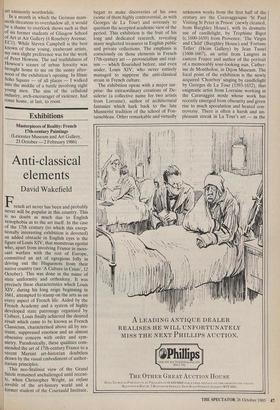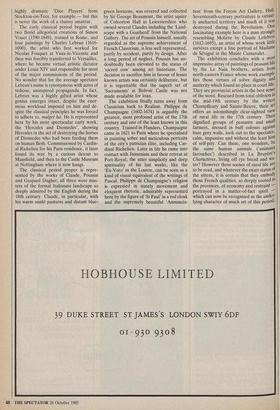Exhibitions
Masterpieces of Reality: French 17th-century Paintings (Leicester Museum and Art Gallery, 23 October — 2 February 1986)
Anti-classical elements
David Wakefield
French art never has been and probably never will be popular in this country. This is no doubt as much due to English xenophobia as to the art itself. In the case of the 17th century (to which this excep- tionally interesting exhibition is devoted) an added obstacle in English eyes is the figure of Louis XIV, that monstrous egotist who, apart from involving France in inces- sant warfare with the rest of Europe, committed an act of egregious folly in driving out the Huguenots from their native country (see 'A Culture in Crisis', 12 October). This was done in the name of state uniformity and orthodoxy. It was precisely these characteristics which Louis XIV, during his long reign beginning in 1661, attempted to stamp on the arts as on every aspect of French life. Aided by the French Academy and a system of highly developed state patronage organised by Colbert, Louis finally achieved the desired result which came to be known as French Classicism, characterised above all by res- traint, suppressed emotion and an almost obsessive concern with order and sym- metry. Paradoxically, these qualities com- mended the art of 17th-century France to a recent Marxist art-historian doubtless drawn by the visual embodiment of author- itarian principles. This neo-Stalinist view of the Grand Siècle remained unchallenged until recent- ly, when Christopher Wright, an enfant terrible of the art-history world and a former student of the Courtauld Institute, began to make discoveries of his own (some of them highly controversial, as with Georges de La Tour) and seriously to question the accepted academic view of the period. This exhibition is the fruit of his long and dedicated research, revealing many neglected treasures in English public and private collections. The emphasis is consciously on those elements in French 17th-century art — provincialism and real- ism — which flourished before, and even under, Louis XIV, who never entirely managed to suppress the anti-classical strain in French culture.
The exhibition opens with a major sur- prise: the extraordinary creations of De- siderio (a collective name for two artists from Lorraine), author of architectural fantasies which hark back to the late Mannerist tradition of the school of Fon- tainebleau. Other remarkable and virtually unknown works from the first half of the century are the Caravaggesque 'St Paul Visiting St Peter in Prison' (newly cleaned, from Burghley House), with its dramatic use of candlelight, by Trophime Bigot (c.1600-1650) from Provence; 'The Virgin and Child' (Burghley House) and 'Fortune Teller' (Heim Gallery) by Jean Tassel (1608-1667), an artist from Langres in eastern France and author of the portrait of a memorably sour-looking nun, Cather- ine de Montholon, in Dijon Museum. The focal point of the exhibition is the newly acquired 'Choirboy' singing by candlelight by Georges de La Tour (1593-1652), that enigmatic artist from Lorraine working in the Caravaggist mode whose work has recently emerged from obscurity and given rise to much speculation and heated con- troversy. There is often a harsh and un- pleasant streak in La Tour's art — in the highly dramatic 'Dice Players' from Stockton-on-Tees, for example — but this is never the work of a clumsy amateur.
The early classical period begins with two florid allegorical creations of Simon Vouet (1590-1649), trained in Rome, and four paintings by Charles Lebrun (1616- 1690), the artist who first worked for Nicolas Fouquet at Vaux-le-Vicomte and then was forcibly transferred to Versailles, where he became virtual artistic dictator under Louis XIV and responsible for most of the major commissions of the period. No wonder that for the average spectator Lebrun's name is synonymous with acres of tedious, uninspired propaganda. In fact, Lebrun was a highly gifted artist whose genius emerges intact, despite the enor- mous workload imposed on him and de- spite the classical principles he was forced to adhere to, malgre lui. He is represented here by his most spectacular early work, the 'Hercules and Diomedes', showing Hercules in the act of destroying the horses of Diomedes who had been feeding them on human flesh. Commissioned by Cardin- al Richelieu for his Paris residence, it later found its way by a curious detour to Mansfield, and then to the Castle Museum at Nottingham where it now hangs.
The classical period proper is repre- sented by the works of Claude, Poussin and Gaspard Dughet; all three were mas- ters of the formal Italianate landscape so deeply admired by the English during the 18th century. Claude, in particular, with his warm sunlit pastures and distant blue-. green horizons, was revered and collected by Sir George Beaumont, the artist squire of Coleorton Hall in Leicestershire who owned several Claudes including the 'Land- scape with a Goatherd' from the National Gallery. The art of Poussin himself, usually regarded as the supreme achievement of French Classicism, is less well represented, partly by accident, partly by design. After a long period of neglect, Poussin has un- doubtedly been elevated to the status of `sacred cow' among art historians. The decision to sacrifice him in favour of lesser known artists was certainly deliberate, but it is regrettable that the superb set of `Sacraments' at Belvoir Castle was not made available for loan.
The exhibition finally turns away from Classicism back to Realism. Philippe de Champaigne (1602-1674) is arguably the greatest, most profound artist of the 17th century and one of the least known in this country. Trained in Flanders, Champaigne came in 1621 to Paris where he specialised in painting sober and meticulous portraits of the city's patrician elite, including Car- dinal Richelieu. Later in life he came into contact with Jansenism and their retreat at Port-Royal; the utter simplicity and deep spirituality of his last works, like the `Ex-Voto' in the Louvre, can be seen as a kind of visual equivalent of the writings of Pascal. Philippe de Champaigne's religion is expressed in stately movement and eloquent rhetoric, admirably represented here by the figure of 'St Paul' in a red cloak and the supremely beautiful 'Annuncia- tion' from the Ferens Art Gallery, Hull. Seventeenth-century portraiture is virtual- ly uncharted territory and much of it was destroyed during the Revolution. One fascinating example here is a man strongly resembling Moliere by Claude Lefebvre (1612-1695), an artist of whose work little survives except a fine portrait of Madame de Sevigne in the Musee Carnavalet. The exhibition concludes with a most impressive array of paintings of peasant life by the Le Nain brothers, artists from north-eastern France whose work exempli- fies those virtues of sober dignity and austerity which found no place in court life. They are provincial artists in the best sense of the word. Rescued from total oblivion in the mid-19th century by the writers Champfleury and Sainte-Beuve, their art offers an astonishingly clear-sighted view of rural life in the 17th century. Their dignified groups of peasants and small farmers, dressed in buff colours against bare grey walls, look out to the spectator, calm, impassive and without the least hint of self-pity. Can these, one wonders, be the same human animals (`animaux farouches') described in La Bruyere's Characteres, living off rye bread and wa- ter? However these scenes of rural life are to be read, and whatever the exact status of the sitters, it is certain that they embody those French qualities, so deeply rooted in the provinces, of economy and restraint --- portrayed in a matter-of-fact spirit — which can now be recognised as the under- lying character of much art of this period.
NOY



























































 Previous page
Previous page